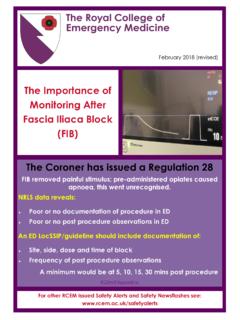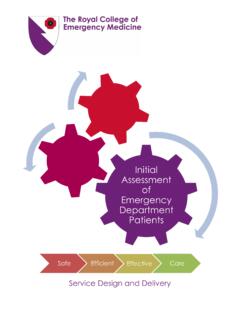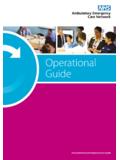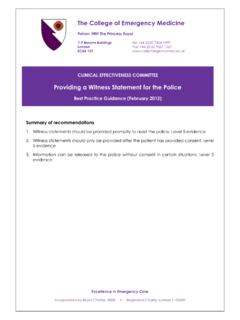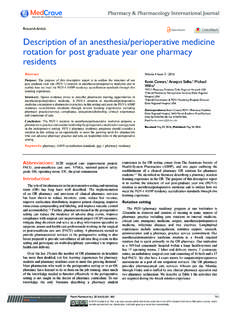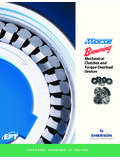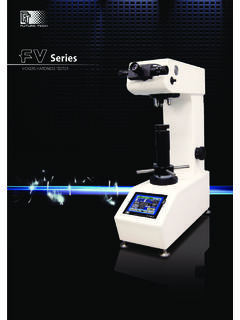Transcription of The Royal College of Emergency Medicine Best …
1 Intravenous Regional Anaesthesia for Distal Forearm Fractures (Bier s block ) (revised Nov 2017) 1 The Royal College of Emergency Medicine Best Practice Guideline Intravenous Regional Anaesthesia for Distal Forearm Fractures (Bier s block ) Revised: November 2017 Intravenous Regional Anaesthesia for Distal Forearm Fractures (Bier s block ) (revised Nov 2017) 2 Summary of recommendations 1. Patients should receive a full explanation about the procedure and consent is obtained before the procedure. 2. Departmental certification and verification of competence is recommended. Only those credentialed by the Emergency Department should perform the procedure.
2 3. The procedure should be performed in an appropriately sited, well lit, and equipped area with resuscitative equipment available in the department. 4. Two practitioners, one of whom is credentialed by the department to perform Bier s block , should be present for the entire procedure. 5. Immediately prior to the procedure an invasive procedures checklist should be completed. 6. A double pneumatic Tourniquet cuff should be used in case rotation of cuff is needed. If rotation of cuff is considered then the machine should have a fail-safe selected preventing decompression of proximal cuff prior to inflation of distal cuff. The cuff should be checked for leaks (a common leak is split rubber o ring on clip for cuff).
3 7. Cuff should be kept inflated for a minimum of 20 minutes and for a maximum of 45 minutes. Timing of cuff times and inflation pressure reading should be clearly documented. 8. Effectiveness of this guideline should be continuously monitored by means of audit, clinical incident review, clinician feedback, and patient complaints. 9. Clinical staff using local anaesthetics should have ready access to intra-lipid. Intravenous Regional Anaesthesia for Distal Forearm Fractures (Bier s block ) (revised Nov 2017) 3 Scope To assist Emergency physician using intravenous regional anaesthesia (Bier s block ) for adults in the Emergency Department requiring manipulation for distal forearm fractures.
4 Reason for development To help the clinician in performing an intravenous regional anaesthesia (IVRA), standardise and improve patient care. Introduction Fracture of the distal forearm fractures is a frequent presentation to every Emergency Department with a prevalence of 9/10,000 in men and 37/10,000 in women aged more than 35 years and above. A proportion of these fractures require manipulation within the Emergency Department using the two commonest methods either Haematoma block or Bier s block (IVRA). There is evidence to state that haematoma block provides less analgesia and can compromise reduction.
5 Due to reported toxicity of different local anaesthetic agents, Bupivacaine and more rarely lignocaine, Prilocaine is the recommended agent for use in intravenous regional anaesthesia. Indication: Reduction of wrist fractures, most commonly Colles fracture. Contraindications: Allergy to local anaesthetic Children consider whether appropriate on individual basis Hypertension >200mm Hg Infection in the limb Lymphoedema Methaemoglobinaemia Morbid obesity (as the cuff is unreliable on obese arms) Peripheral vascular disease Procedures needed in both arms Raynaud s phenomenon Scleroderma Severe hypertension Sickle cell disease or trait Pagets Disease Uncooperative or confused patient Intravenous Regional Anaesthesia for Distal Forearm Fractures (Bier s block ) (revised Nov 2017) 4 Drug and Dose or 1% prilocaine without preservative No preparation with adrenaline Prilocaine 3mg/Kg.
6 There are no reported problems at this dose. If prilocaine unavailable, use half volume of 1% plain prilocaine and the same volume of normal saline (eg instead of 40ml plain prilocaine, use 20 ml 1% plain prilocaine and dilute with 20ml normal saline) During a period of prilocaine shortage in the UK, the following regime was found to be an acceptable alternative; plain lidocaine at a dose of 3 mg/kg up to a maximum of 200 mg (40 ml) Weight (Kg) Dose (at 3mg/kg) Total volume of prilocaine (ml) 80 240 48 70 210 42 60 180 36 50 150 30 40 120 24 Technique: Immediately prior to the procedure an invasive procedures checklist should be completed.
7 Check for the following Consent Patient weight in kilograms Fasting not required Patient transferred to resus or appropriately sited, well lit, and equipped with resuscitative equipment available in department ECG, BP and pulse oximeter to monitor patient throughout the procedure Check air cylinder at least 1/4th full if electronic machine not used. Electronic machines must be kept on charge when being stored between procedures. Cuff checked for leaks (a common leak is split rubber o ring on clip for cuff ) Drug to be used (prilocaine) Drug dosage and preparation Awareness of the location of stocked Emergency drugs IV access on normal side 22G in case of complications which require systemic drug administration IV access, distal to the cuff, with small bore cannulae (22G) on the side to be anaesthetised.
8 Proximal vein can be used but injection should be slow and wait 13 mins for effect Radiographer informed about the requirement of post reduction film There is some evidence to support use of ultrasound guidance to aid reduction Intravenous Regional Anaesthesia for Distal Forearm Fractures (Bier s block ) (revised Nov 2017) 5 Procedure: Place double cuff tourniquet on upper arm and not on forearm as adequate arterial compression cannot be obtained. Padding must always be applied prior to cuff placement and applying a well fitted double cuff will be a 2 person procedure If a plaster has already been applied then apply tourniquet before removing the plaster Elevate the injured arm to exsanguinate the limb Inflate the proximal cuff to 100mmHg above the systolic BP or up to a maximum of 300mmHg.
9 If rotation of cuff is considered then the machine should have a fail-safe selected preventing decompression of proximal cuff prior to inflation of distal cuff. Record the time of inflation Check for the absence of radial pulse Inject plain prilocaine, prepared according to patient weight, slowly and record the time of injection. Remove the cannula and apply pressure as the venupuncture site is prone to bleed (thus use of 22G) Warn the patient about the cold/hot sensation and mottled appearance of the arm Check for anaesthesia, may sense movement but not pain after 10 minutes which is when the manipulation should be done and plaster applied by 2nd member of staff Lower arm on to a pillow and obtain check x-ray Tourniquet dials must be under observation at all times Watch for signs of toxicity The cuff must be inflated for a minimum of 20 minutes and a maximum of 45 minutes.
10 If rotation of cuff required because of pain at cuff site or prolonged procedure (2nd manipulation) this should done after the manipulation and plaster is applied. The distal cuff will then be inflated over an anesthetised area and be more comfortable for the patient. If satisfied with the post reduction position of fracture, deflate the cuff observing the patient and monitor If fail safe selection applied the distal cuff will need to be inflated first prior to deflations Record the time of deflation Check limb circulation prior to discharge and arrange patient follow up and analgesia as appropriate Systemic Toxicity for local anaesthetics Note: none have been recorded using Prilocaine at 3mg/kg dose for IVRA.
